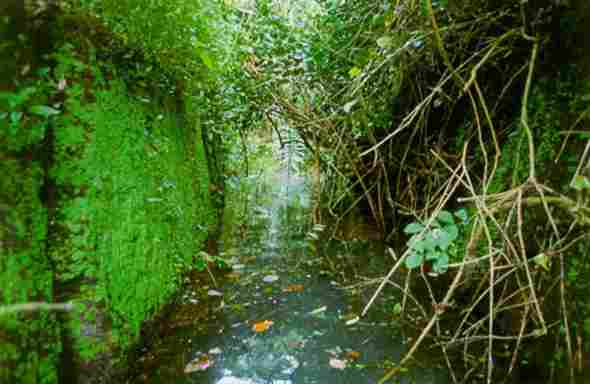This blog post was a term paper that I wrote in grad school at the University of Tennessee, Knoxville, College of Architecture and Design in my LAR 581 class taught by Dr. Avigail Sachs. December 2015
“Whenever a settled group of people recognize themselves as an entity, they like to have some explanation of their origins, they do not like to feel they are without roots.”1
– Thurstan Shaw
One of the best ways to understand a group or culture of people is to look at the monuments they have constructed. The construction of monuments is surprisingly ubiquitous throughout the world and their purposes range from the worship of gods to preservation and burial of the dead to even self-indulgence. In the case of Nigeria, its greatest monument is believed to have been built around 800 AD to 1000 AD for a defensive purpose of protection from political confrontation in the southern Nigerian rainforest. That monument is the Hadithi ya Sankofa: Sungbo’s Eredo, the most breathtaking landscape site in Nigeria and Africa’s largest pre-colonial monument. The ramparts of Sungbo’s Eredo are believed to have been built in the Ijebu-Ode Kingdom ruled by the Awujale, which means spiritual leader. After a millennia, its remains were surveyed by archaeologist Dr. Patrick Darling who found out that these walls and ditches reached heights of over 70 feet and stretch over 100 miles (170 km) in circumference over Ogun State, Benin Iya, Ile-Ife, and Ilesa in southwest Nigeria. An estimated 3.5 million cubic meters of earth was moved by the builders which Darling confirmed is “more earth than the Great Pyramid of Giza, making Sungbo’s Eredo the largest historical monument in the world.”2
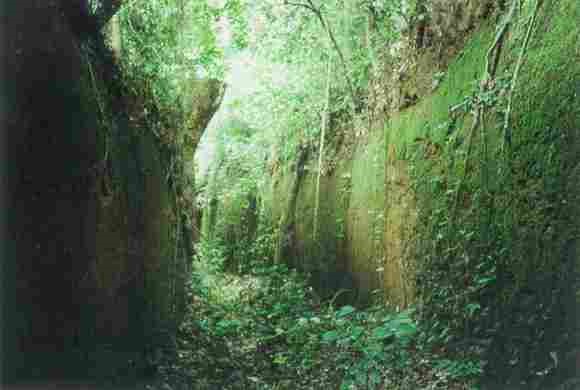
Figure 1: The earthen ramparts of Sungbo’s Eredo (Source: Wa NyaKale, M. (2011, February 22). Sungbo’s Eredo: Nigeria’s hidden wonder. Retrieved September 1, 2015, from https://molisa.wordpress.com/2011/02/22/hadithi-ya-sankofa-sungbos-eredo/)
So this monument compares in size and spectacle to many well-known monuments around the world. It differs greatly from its counterparts, however, because these earthen walls have not been excavated and studied in detail, which means there is limited knowledge both academically and generally about it. Thurstan Shaw stated that “there are whole regions of Nigeria which are still virgin to archaeological penetration, there are whole centuries and even millennia which are virtually historical blanks, and many problems are unresolved.”3 This lack of attention is not unique to this monument as this problem affects many of Nigeria’s historical sites. It is often attributed to its location, a region plagued by colonization, civil war, poverty and famine, which has left the current residents indifferent to their past. In this paper, I argue that far from being indifferent, present day Nigerians have an intense interest in their past and its monuments, but do not have the resources to fully explore and uncover them. This analysis is thus offered as a starting point for changing this trend and developing a robust historical analysis in Nigeria. First, I will discuss the current arguments of the survival only mentality put forth by Onishi, Obuntan, and Johnson. Then, I will present my argument for why their arguments do not present the entire story and what can be done to change it.
Nigeria is a country of conflicting priorities, ideas, and beliefs. While often conflicts lead to better compromises, it just doesn’t seem to be the case for Nigeria or Africa as a whole. During the late 19th and early 20th century, European influences seemed to divide an already divided Africa. The Berlin Conference, a gathering of European powers meant to partition the continent of Africa into lucrative pieces for the colonizers in 1884-85, was not a precise evaluation of the continent, its people, tribes, or culture. The Europeans simply drew lines upon maps, especially on places they have never been before, for their economic and colonial gains. Needless to say this caused problems for the people of Africa, as today, “close to 100 active border disputes exist across the continent.”4 Border disputes stem from tribes of people being grouped together that were never meant to be unified and governed as a country. These disputes are similar to those in Iraq as the Shiites and Sunnis were grouped together after European powers conducted similar mapping exercises. After Nigeria was able to regain its independence for Britain in 1960, conflicts of politics, culture, religion (Christianity and Islam), led to the 1967 Civil War that lasted for 3 years. The war thrusted Nigeria into poverty, famine, starvation, and military rule.5
What does this conflict mean for history and culture of landscape architecture in Nigeria? A great shift of priorities from historical and cultural preservation to survival. For a long period of time, the survival mentality, from war and famine, have cause these monuments to be “ignored by locals and government officials alike.” Beatrice Fisher, an official at Legacy, a private conservation group based in Lagos, Nigeria, said “When you are a developing country, the primary goal is to survive. Important issues like preservation of history tend to take a back seat in times of turmoil.”6 Many of Nigeria’s monuments, like Sungbo’s Eredo, “lie in ruin, or are hidden in the nearly impenetrable rainforest” and have only recently been cataloged and protected. After a few generations of neglect by the people of Nigeria, the knowledge and importance of these monuments decreases. Nigerians today can be seen regularly “walking atop the remains of the walls in Nigeria’s ancient city of Kano”, for example, not necessarily because they don’t care, but because they are unaware of what they are walking on. Some that are aware of what the monuments and artifacts are have gone as far as to “loot and sell them overseas” just to get by.7
If a majority of the people don’t value or remember history, it is much harder for the government to as well. The military government after Nigerian Independence and the Civil War seemed to have other priorities other than preservation. Willie Nwokedi, president of Legacy said “the need to preserve artifacts and monuments (like Sungbo’s Eredo) has attracted little government attention, as the military governments have allowed the country’s historical sites to deteriorate.”8 Why has the government neglected this history? Corruption may have been a strong factor to the neglect of the monuments. Because it was more economically viable to sell a historical site to be used in oil drilling, for example, they have decided to sell these sites for industrial use.
This is a large problem. It seems that Nigeria is currently under a state of identity crisis because of a loss of sight who they are and where they came from. Obuntan writes about the conflict and border disputes that lead to what Onishi talked about, which was the state of the people of Africa today and some reasons why. What about some of the history that was lost? History and culture are heavily tied to each other. While history might seem as if it is permanent and unchanging, culture is much less so. L. C. Dioka wrote about the fact that “culture is dynamic and undergoes changes while retaining some aspects of itself.”9 Because culture is fluid and is passed down through generations of people, some of the related history inevitably gets forgotten or discarded. This cultural effect on history is further exacerbated when the culture did not prioritize written history and instead verbally passed it down. Gerard Chouin, a professor of history at William & Mary, is currently working hard to find evidence to support his belief that the bubonic plague had a role to play in the sudden disappearance of knowledge of Sungbo’s Eredo. Chouin is studying the skeletons found in mass graves in the Yoruba state. Because teeth are connected directly to the bloodstream, which the plague traveled through, they are a good source to find the disease DNA to prove or disprove his hypothesis. So in the case of a verbally recorded society, if a natural disaster destroys a majority of the people living in the urban areas protected by Sungbo’s Eredo, history is bound to be lost and culture changed. The bubonic plague is just one of many theories that Chouin and other archaeologists are researching to shed some light on this issue and fill the historical gaps left by a changing culture.10
The lack of knowledge now drives the search rather than deters from it. This interest in the archaeology of Nigeria has been growing steadily as more information is uncovered. As stated earlier, history and culture are closely tied together and as more historical information is gathered from the finding of artifacts to the interviewing of tribal elders, more light is shed on reasons why the culture is the way it is today.
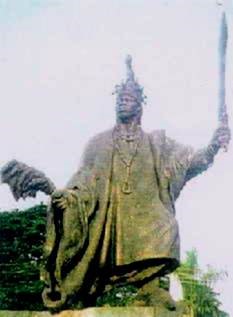
Figure 2: Statue of the Great Queen Sheba (Source(Source: Wa NyaKale, M. (2011, February 22). Sungbo’s Eredo: Nigeria’s hidden wonder. Retrieved September 1, 2015, from https://molisa.wordpress.com/2011/02/22/hadithi-ya-sankofa-sungbos-eredo/)
Johnson talked about the history of the monument of Sungbo’s Eredo and its ties to the legend of Queen Sheba. It is believed that the construction of the earthen walls of Sungbo’s Eredo were “connected to the legend of Queen Sheba which is recounted in both the Bible and Koran.”11 According to the Old Testament of the Bible, she was an amazing leader from Ethiopia who married King Solomon after sending him a camel train of gold and ivory. Their son started a dynasty of Ethiopian rulers. Queen Sheba’s conversion to Islam had a big influence on the religious state of Nigeria. Johnson states that “the Koran, describes the queen as a worshipper of the Sun god based in the Arabian Peninsula, who converted to Islam.” Today, religion has a lot to do with the divide of Nigeria as well. The country is split from West to East in the middle with the North being majority Muslim and the South being majority Christian. Monuments like Sungbo’s Eredo have been split with some being places of worship by both based on where they happened to fall in Nigeria’s religious divide.12
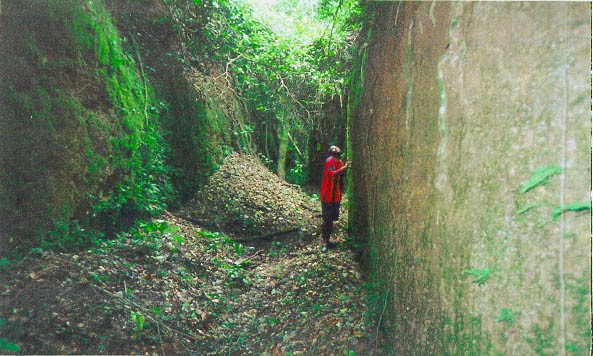
Figure 3: Local admiring the walls of Sungbo’s Eredo (Source: Nigieria’s Hidden Wonder, BBC News, http://news.bbc.co.uk/2/hi/programmes/from_our_own_correspondent/364754.stm)
Sungbo’s Eredo is believed to be a wall dividing ancient African cities but was also believed to be ultimately a connector between them. Nigeria’s ability to preserve and reconnect with their history will be important for their resolution of conflict. I believe Nigeria has this ability due to the fact that Nigerian nationalism is alive and well. With the birth and growth of British colonization in the early 20th century, came the rise and outward expression of nationalism. Nigerians began to look back on themselves with pride and promoted the food, names, clothing, and languages of traditions past. Embracing more national heritage in a country that was once divided by tribes and languages was a big deal and only came about under the dominance of British influence. The prevalence of nationalism was exacerbated with the rapid changes that occurred due to urbanization, Western education, and transportation.13
As in other countries, modernism fundamentally changed the landscape of Nigeria. Pre-colonial Nigerians lived off the land and heavily depended on the resources readily available around them. With the little archaeology that has been done, archaeologists, like Shaw, have been able to uncover a vast variety of acheulian and sangoan tools, artifacts, and precious metals, like iron and bronze, that demonstrate the sophistication of ancient Nigerian civilizations. For example, the ancient Yoruba tribe, which resides in Ile Ife one of the main site of Sungbo’s Eredo, is known for their artistic craftsmanship in sculpting life-sized representations of human heads with amazing naturalistic style. Over centuries, these artifacts were carefully hidden and respected by the local Yoruba because they were believed to be holy. The shows the high level of respect of heritage that was present in the pre-colonial Nigerian tribes. It wasn’t until 1910 that outsiders, like German ethnographer Leo Frobenius, were even allowed to see the artifacts to study them.14 There is also evidence to suggest that the Yoruba people had invented genius ways to handle life in the thick of the rainforest. Chouin explains a pavement innovation proving that the Yoruba people were a force to reckon with and why the interest in their ancient civilization among the scholarly is increasing.
“The public courtyards were actually covered with pavement. They were paved with potshards, which were placed vertically, which creates millions of small gutters, because the pottery creates little channels. Basically it was a way to evacuate water and to keep your feet dry.”15
These valuable resources were in high demand as British colonialism began. European influence and colonial interests made it difficult for Nigerians to gain back access to those valuable resources that their ancestors had in abundance which made it difficult of the people to protect and pass on knowledge of the important sites and monuments. This discrepancy is no longer the norm. With an abundance of new technology, exploring the rain forests of Africa has never been easier or more accurate. Like the cellphone, Drones, GIS, and GPS technologies are tools that are really starting to come online and will allow archaeologists from Nigeria and around the world to close the knowledge gap. Since resources are scarce, Nigerians can’t afford to excavate every historical site without knowing beforehand what they might uncover. Drones, GIS, and GPS give sight to the previously unseen, illuminating the areas that researchers should focus their efforts. Chouin and other researchers plan to use drones and GIS to map the paths and locations of artifacts and other remnants like the pavement shards in the public courtyards.16
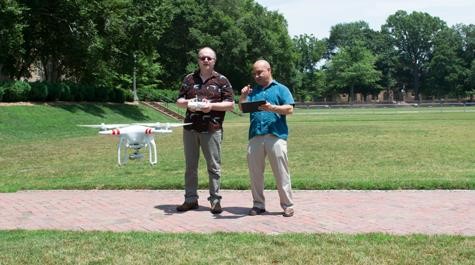
Figure 4: Gerard Chouin (left) and Sean Pada (right) control drone using an iPad, which he will to map in Nigeria. (Source: “BRING OUT YOUR DRONES: TO YORUBALAND ON THE TRAIL OF THE BLACK DEATH.” States News Service 2 June 2015. Academic OneFile. Web. 7 Dec. 2015) Photo by Joseph McClain
More research efforts like be necessary moving forward. I believe that both Nigerians and Western authorities can work together, despite a murky past, to really learn about and respect the past to impact the future of Nigeria. It is evident to me that a shift in priorities is occurring and changes are taking place. The people of Nigeria can solve border dispute conflicts, gain access to and properly manage resources for research and discovery, and begin to reconnect with their past.
“You will never know where you are going unless you know where you are coming from.”17
– Fela Anikulapo-Kuti
References
Featured Image https://csweb.bournemouth.ac.uk/africanlegacy/orile_owu.htm
- Shaw, Thurstan. Nigeria : Its Archaeology and Early History (1978). Print. pp. 9
- Wa NyaKale, M. (2011, February 22). Sungbo’s Eredo: Nigeria’s hidden wonder. Retrieved September 1, 2015, from https://molisa.wordpress.com/2011/02/22/hadithi-ya-sankofa-sungbos-eredo/
- Shaw, Thurstan. Nigeria : Its Archaeology and Early History (1978). Print. pp. 9-14
- Oduntan, Gbenga. “Africa’s Border Disputes Are Set to Rise – but There Are Ways to Stop Them [analysis].” All Africa 14 July 2015: All Africa, July 14, 2015. Web. 1 Oct. 2015.
- Wikipedia contributors. “Nigerian Civil War.” Wikipedia, The Free Encyclopedia. Wikipedia, The Free Encyclopedia, 28 Sep. 2015. Web. 1 Oct. 2015.
- Onishi, Norimitsu. “Eredo Journal; A Wall, a Moat, Behold! A Lost Yoruba Kingdom.” New York Times 20 Sept. 1999. Academic OneFile. Web. 1 Oct. 2015.
- Onishi, Norimitsu. “Eredo Journal; A Wall, a Moat, Behold! A Lost Yoruba Kingdom.” New York Times 20 Sept. 1999. Academic OneFile. Web. 1 Oct. 2015.
- Onishi, Norimitsu. “Eredo Journal; A Wall, a Moat, Behold! A Lost Yoruba Kingdom.” New York Times 20 Sept. 1999. Academic OneFile. Web. 1 Oct. 2015.
- Osuntokun, Akinjide., and Olukoju, Ayodeji. Nigerian Peoples and Cultures (1997). Print. 80-81
- McClain, Joseph “BRING OUT YOUR DRONES: TO YORUBALAND ON THE TRAIL OF THE BLACK DEATH.” States News Service 02 June 2015: States News Service, June 2, 2015. Web.
- Johnson, Bamidele. “Nigeria’s Claim To Queen Of Sheba.” Africa News Service 23 Mar. 2000: 1008082u7980. General OneFile. Web. 1 Oct. 2015.
- Johnson, Bamidele. “Nigeria’s Claim To Queen Of Sheba.” Africa News Service 23 Mar. 2000: 1008082u7980. General OneFile. Web. 1 Oct. 2015.
- Falola, Toyin. History of Nigeria. Westport, CT, USA: Greenwood Press, 1999. ProQuest ebrary. Web. 5 November 2015.
- McClain, Joseph “BRING OUT YOUR DRONES: TO YORUBALAND ON THE TRAIL OF THE BLACK DEATH.” States News Service 02 June 2015: States News Service, June 2, 2015. Web.
- McClain, Joseph “BRING OUT YOUR DRONES: TO YORUBALAND ON THE TRAIL OF THE BLACK DEATH.” States News Service 02 June 2015: States News Service, June 2, 2015. Web.
- McClain, Joseph “BRING OUT YOUR DRONES: TO YORUBALAND ON THE TRAIL OF THE BLACK DEATH.” States News Service 02 June 2015: States News Service, June 2, 2015. Web.
- Shaw, Thurstan. Nigeria : Its Archaeology and Early History (1978). Print. pp. 7
